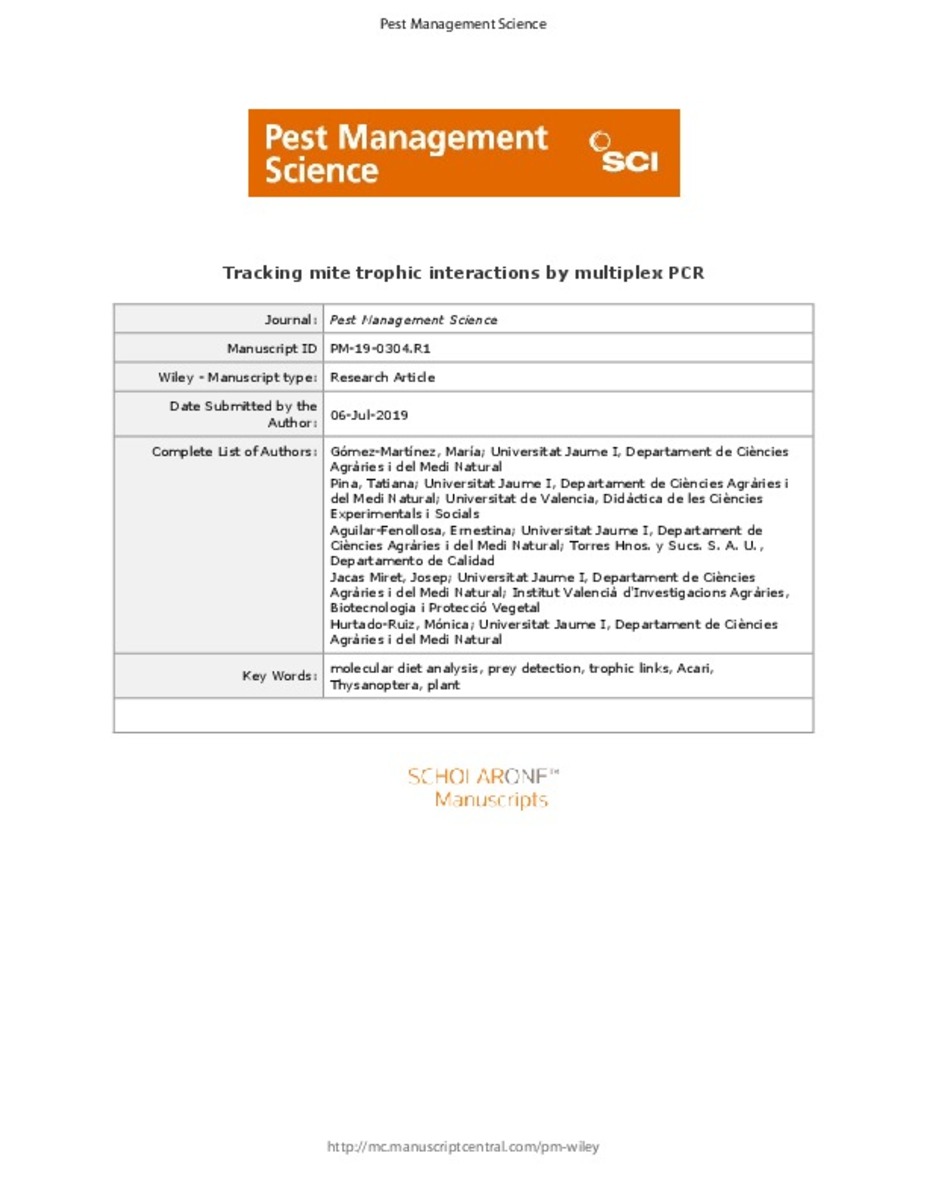Mostrar el registro sencillo del ítem
Tracking mite trophic interactions by multiplex PCR
| dc.contributor.author | Gómez-Martínez, María Antonia | |
| dc.contributor.author | Pina, Tatiana | |
| dc.contributor.author | Aguilar-Fenollosa, Ernestina | |
| dc.contributor.author | Jaques , Josep A. | |
| dc.contributor.author | Hurtado-Ruiz, Monica | |
| dc.date.accessioned | 2020-09-11T11:03:17Z | |
| dc.date.available | 2020-09-11T11:03:17Z | |
| dc.date.issued | 2020 | |
| dc.identifier.citation | GÓMEZ‐MARTÍNEZ, María Antonia, et al. Tracking mite trophic interactions by multiplex PCR. Pest Management Science, 2020, vol. 76, no 2, p. 597-608. | ca_CA |
| dc.identifier.issn | 1526-498X | |
| dc.identifier.issn | 1526-4998 | |
| dc.identifier.uri | http://hdl.handle.net/10234/189661 | |
| dc.description.abstract | BACKGROUND A thorough knowledge of trophic webs in agroecosystems is essential to achieve successful biological pest control. Phytoseiid mites are the most efficient natural enemies of tetranychid mites, which include several important pests worldwide. Nevertheless, phytoseiids may feed on other food sources including other microarthropods, plants and even other phytoseiids (intraguild predation), which can interfere with biological control services. Molecular gut content analysis is a valuable tool for characterizing trophic interactions, mainly when working on microarthropods such as mites. We have designed new primers for Phytoseiidae, Tetranychidae and Thysanoptera identification and they have been multiplexed in a polymerase chain reaction (PCR) together with universal plant primers. Additionally, we have estimated prey DNA detectability success over time (DS50) considering the most probable events in Spanish citrus orchards: the phytoseiid Euseius stipulatus as a predator, the phytoseiid Phytoseiulus persimilis as intraguild prey, and the thrips Frankliniella occidentalis and Anaphothrips obscurus as alternative prey to Tetranychus urticae. RESULTS The designed multiplex PCR allows the identification of phytoseiids (both predator and intraguild prey) and detects alternative food sources mentioned above in the gut of the phytoseiid predator. DS50 for E. stipulatus as the predator were 1.3, 2.3 and 18.7 h post feeding for F. occidentalis, A. obscurus and P. persimilis as prey, respectively. CONCLUSION Tracking of the trophic relationships within the citrus acarofauna, and the unveiling of the role of alternative food sources will pave the way for enhancing T. urticae biological control. This multiplex PCR approach could be applicable for these purposes in similar agroecosystems. | ca_CA |
| dc.format.extent | 37 p. | ca_CA |
| dc.format.mimetype | application/pdf | ca_CA |
| dc.language.iso | eng | ca_CA |
| dc.publisher | Wiley | ca_CA |
| dc.relation.isPartOf | Pest Management Science, 2020, vol. 76, no 2, p. 597-608. | ca_CA |
| dc.rights | © 2019 Society of Chemical Industry. "This is the pre-peer reviewed version of the following article: GÓMEZ‐MARTÍNEZ, María Antonia, et al. Tracking mite trophic interactions by multiplex PCR. Pest Management Science, 2020, vol. 76, no 2, p. 597-608., which has been published in final form at https://doi.org/10.1002/ps.5555. This article may be used for non-commercial purposes in accordance with Wiley Terms and Conditions for Use of Self-Archived Versions." | ca_CA |
| dc.rights.uri | http://rightsstatements.org/vocab/InC/1.0/ | * |
| dc.subject | molecular diet analysis | ca_CA |
| dc.subject | prey detection | ca_CA |
| dc.subject | trophic links | ca_CA |
| dc.subject | Acari | ca_CA |
| dc.subject | Thysanoptera | ca_CA |
| dc.subject | plant | ca_CA |
| dc.title | Tracking mite trophic interactions by multiplex PCR | ca_CA |
| dc.type | info:eu-repo/semantics/article | ca_CA |
| dc.identifier.doi | https://doi.org/10.1002/ps.5555 | |
| dc.relation.projectID | AGL2011‐30538‐C03‐01 , AGL2014‐55616‐C3‐3‐R, P1·1B2012‐15 | ca_CA |
| dc.rights.accessRights | info:eu-repo/semantics/openAccess | ca_CA |
| dc.relation.publisherVersion | https://onlinelibrary.wiley.com/doi/10.1002/ps.5555 | ca_CA |
| dc.type.version | info:eu-repo/semantics/submittedVersion | ca_CA |
Ficheros en el ítem
Este ítem aparece en la(s) siguiente(s) colección(ones)
-
CAMN_Articles [566]







